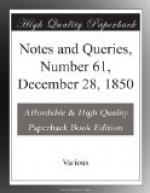Meaning of the Word “Thwaites"(Vol. ii., p. 441.).—The word “Thwayte” occurred in the ancient form of the Bidding Prayer: “Ye shalle byddee for tham, that this cherche honour with book, with bell, with vestiments, with Thwayte,” &c. This form is said to be above four hundred years old; and Palmer says (Orig. Lit., iii. p. 60.) that we have memorials of these prayers used in England in the fourteenth century. Hearne remarks that the explication of this word warranted by Sir E. Coke is “a wood grubbed up and turned to arable.” This land being given to any church, the donors were thus commended by the prayers of the congregation.
In Yorkshire the word is so understood: Thwaite, or “stubbed ground, ground that has been essarted or cleaned.”
J.H.M.
Meaning of “Thwaites" (Vol. ii., p. 441.).—Hearne took the word “Thwayte” to signify “a wood grubbed up and turned into arable.” His explanation, with other suggestions as to the meaning, of this word, may be found in a letter from Hearne to Mr. Francis Cherry, printed in vol. i. p. 194. of Letters written by Eminent Persons in the Seventeenth and Eighteenth Centuries, published by Longman and Co. in 1813.
J.P. JR.
December 5. 1850.
Thomas Rogers of Horninger (Vol. ii., p. 424.).—Your correspondent S.G. will find a brief notice of this person in Rose’s Biographical Dictionary, London, 1848. It appears he was rector of Horninger, and a friend of Camden; who prefixed some commendatory verses to a work of his, entitled The Anatomy of the Mind. I would suggest to S.G. that further information may probably be collected respecting him from these verses, and from the prefaces, &c. of his other works, of which a long list is given in Rose’s Dictionary.
T.H. KERSLEY, A.B.
King William’s Col., Isle of Man.
Thomas Rogers of Horninger (Vol. ii., p 424.).—If S.G. will apply to the Rev. J. Perowne, of his own college, who is understood to be preparing an edition of Rogers’s work for the Parker Society, he will doubtless obtain the fullest information.
A.H.
Earl of Roscommon (Vol. ii., p. 468.).—A pretended copy of the inscription at Kilkenny West, mentioned by your correspondent AN HIBERNIAN, was produced in evidence, on the claim of Stephen Francis Dillon to the earldom of Roscommon, before the House of Lords. As there was reason to doubt the evidence of the person who produced that copy, or the genuineness of the inscription itself, the House decided against that claim; and by admitting that of the late earl (descended {522} from the youngest son of the first earl) assumed the extinction of all the issue of the six elder sons. The evidence adduced altogether negatived the presumption of any such issue. Your correspondents FRANCIS and AN HIBERNIAN will find a very clear and succinct account of the late earl’s claim, and Stephen Francis Dillon’s counter-claim, in The Roscommon Claim of Peerage, by J. Sidney Tayler, Lond. 1829.




